STATEMENT OF
POSTMASTER GENERAL/CEO PATRICK R. DONAHOE
BEFORE THE
SUBCOMMITTEE ON FEDERAL WORKFORCE, U.S. POSTAL SERVICE & LABOR POLICY
UNITED STATES HOUSE OF REPRESENTATIVES
MARCH 27, 2012
Good morning, Mr. Chairman, and members of the Committee. Thank you for the invitation and thank you, Mr. Chairman, for calling this hearing to discuss recent Postal Service proposals to cut $22.5 billion in costs by 2016, and also provide details on the Postal Service’s proposal to sponsor its own health care program.
My testimony provides a brief synopsis of the Postal Service’s Plan to Profitability, also known as our Five-Year Business Plan, and contains a deeper discussion of the largest single component of that plan – reducing the Postal Service’s health care costs by sponsoring our own health care plan. The Plan to Profitability, created by the Postal Service, has been subjected to rigorous independent review. Implementation of these strategies – and realization of the substantial savings they will produce – is integral to the future of the Postal Service. We are confident that the implementation of these proposals will sustain the Postal Service well into the future.
The Postal Service is at a crossroads. Our business model is broken. We have insufficient revenue to cover our costs and are rapidly approaching our statutory debt limit of $15 billion. If the Postal Service were a private company, we would be engaged in Chapter 11 bankruptcy proceedings. Our financial crisis is the result of a restrictive business model and a permanent and fundamental shift away from First-Class Mail. During the past five fiscal years, the Postal Service recorded cumulative losses of $25 billion. The requirement to prefund Retiree Health Benefits (RHB), mandated by the Postal Accountability and Enhancement Act of 2006 (PAEA), drove $21 billion of the five year losses. It should be noted that development of a Postal Service-sponsored health care plan will eliminate the need to make the prefunding payments mandated by the PAEA. It is clear our current operating costs are unsustainable. [Figure 1]

Figure 1
In the face of these continued unsustainable and crippling losses, the Postal Service developed our Five-Year Business Plan to enhance existing efforts and accelerate completion of a long-standing goal of bringing the Postal Service back to financial stability. Our plan is aggressive. We are taking steps within our control to implement the plan. However, there are limitations on what the Postal Service can accomplish on our own. Portions of the plan are outside the scope of the Postal Service’s control and are achievable only through enactment of legislation. Congress will play a key role in helping the Postal Service close the widening gap between revenue and cost. The financial crisis facing the Postal Service demands both immediate and comprehensive reform. Absent any action at all, from Congress or the Postal Service, we could see deficits exceed $21 billion annually by 2016, with a net debt reaching over $92 billion by the end of 2016. [Figure 2] We do not have sufficient cash to pay $11.1 billion of RHB pre-funding due later this fiscal year. Doing nothing is not an option.
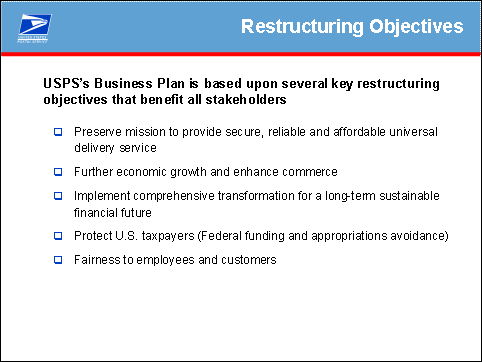
Figure 2
PLAN TO PROFITABILITY
For more than 230 years, the Postal Service has fulfilled our core mission to bind the nation together, currently delivering to every address across the country. The Postal Service continues to be the core component of a mailing industry that employs over 7 ½ million Americans, working for thousands of companies and businesses – all of which are deeply invested in the mail. The mailing industry makes up approximately 7 percent of the country’s Gross Domestic Product (GDP). A review of the performance of postal service providers by the Oxford Strategic Consulting firm ranks the U.S. Postal Service the best postal service within the world’s top 20 largest economies for access to services, resource efficiency and public trust. The study showed the Postal Service delivering 200 percent more efficiently than the next highest ranked post. The importance of a healthy and thriving Postal Service cannot be overstated.
As previously noted, there are multiple factors contributing to the current financial problems that the Postal Service is experiencing. First-Class Mail, the most profitable class of mail, continues to rapidly decline, largely due to electronic diversion. First-Class Mail volume has declined by 25 percent over the past five years, and Postal Service projections show that total mail volume will drop from 168 billion pieces in 2011 to 144 billion pieces by 2016. At the same time, other factors combine to exacerbate the Postal Service’s financial situation. For example, prices on many products are capped at the rate of inflation. This limits the Postal Service’s flexibility to adjust prices in response to market forces or offset temporary cost increases, such as the fuel surcharges commonly employed by our competitors to offset their rising costs. In addition, labor costs continue to rise. These costs account for 80 percent of the Postal Service’s total costs, and 38% of personnel costs are tied to federal benefits programs outside of our control. The Postal Service operates on a fixed cost base that is driven by delivery points, retail locations, mail processing facilities, and six-day delivery. In the future, costs are projected to outpace revenue at an alarming rate.
The Five-Year Business Plan identifies various strategies by which the Postal Service can realize substantial savings by 2016. The plan is based upon several straightforward and simple key objectives. [Figure 3] It includes aggressive actions to reduce annual costs and deliver the changes needed to preserve our mission to provide secure, reliable, and affordable universal delivery service. The plan will advance economic growth, enhance commerce, and provide comprehensive transformation for a long-term sustainable financial future. It requires no appropriated dollars, and is fair to both employees and customers. Implementation of all components of the plan is essential to achieving financial stability. A piecemeal approach – enacting only portions of the plan – or a delay in adoption of all proposals will decrease the projected overall savings.
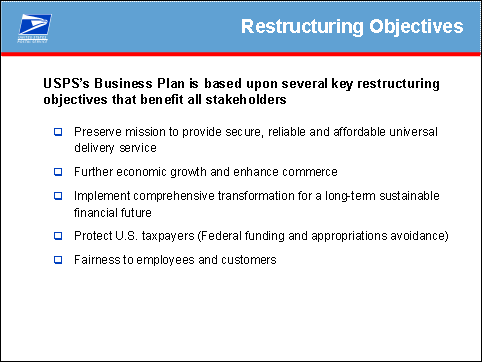
Figure 3
In developing our plan, the Postal Service identified areas over which we have control, areas which require legislation, and areas which call for a combination of solutions from both the Postal Service and Congress. Strategies include improving the efficiency of the network, delivery initiatives, increasing revenue generation and addressing total workforce costs to achieve annual savings of $22.5 billion by 2016. [Figure 4]

Figure 4
Postal Service network costs are fixed and – as the network exists now – are too high for today’s reduced mail volumes. Any responsible employer would not continue to operate unneeded facilities or employ more workers than its business needs. The Postal Service needs the flexibility to realign its people and equipment to better match the precipitous decline in volume. Facilities must be re-evaluated and streamlined, and cost reductions must be realized for local Post Offices. The Postal Service is developing a number of alternatives to closing Post Offices that could sustain offices in rural communities at a reduced cost to the Postal Service. This is still in the discussion stage, but I will be happy to provide additional information as details are finalized.
The plan also addresses the need to reduce the size of our network, which could bring a total projected annual savings of $9 billion. These savings include $4.1 billion in mail processing and transportation costs, $2 billion in retail savings, and $3 billion in delivery operations. To enable the changes in the postal physical infrastructure, service standards (the number of days it takes for mail to be delivered from one ZIP Code to another) must be revised. Service standard changes will allow for an expanded operating window and thus more efficient use of existing equipment and mail processing capacity, and it will eliminate our need for many of our current under-utilized processing plants.
Revenue management is also a key component to the Plan to Profitability. We continue to implement innovative new products and services to generate new revenue. While we have considered and implemented a number of incremental revenue opportunities, the Postal Service is limited in its authority to provide non-postal services. And, research by external consultants shows that, even in European and other liberalized posts, it is not possible to achieve financial stability through revenue initiatives alone, without a fundamental change in the business model.
The Plan to Profitability also contains initiatives to reduce workload and staffing. In response to declining mail volumes and to increase productivity, the Postal Service consolidated over 200 mail processing facilities in the past five years from our peak number of 673 facilities in 2006. In doing so, we have customarily provided a “soft landing” for employees through retirements and reassigning staff, in an effort to minimize impacts on employees. [Figure 5] We have been, and continue to be, a responsible employer.
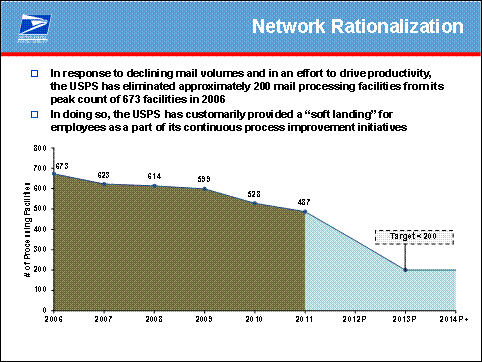
Figure 5
The Postal Service projects a further reduction of the equivalent of 155,000 full-time career employees by 2016, which we plan to achieve largely through attrition as half of our career employees are eligible for optional or early retirement. The Plan to Profitability focuses on workforce reductions through employee attrition versus layoffs or wage reductions, meaning impacted career employees would be able to retire or find another job in the Postal Service. [Figure 6]
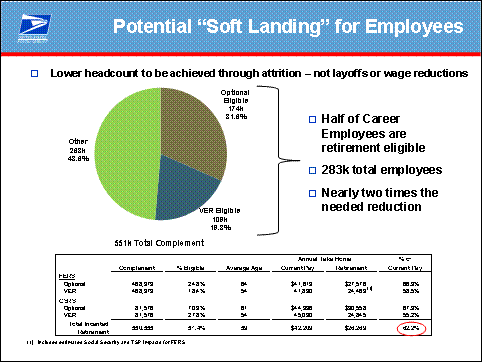
Figure 6
Portions of the Plan to Profitability require targeted legislative changes. These changes represent annual cost reductions that will return the Postal Service to profitability. Strategies that require enactment of legislation include the ability of the Postal Service plan to transition to a five-day per week delivery model. The change in delivery frequency could save the Postal Service $2.7 billion per year. Equally important is legislation directing the return of the overfunding of the Federal Employees’ Retirement System (FERS). The Office of Personnel Management (OPM) has determined that the amount of overfunding stood at $10.9 billion as of September 2010, and OPM has projected that it increased by an additional $500 million during FY 2011. Although the refund would not be a recurring annual savings in the Plan to Profitability, a legislative change that would allow the return of the FERS overfunding would provide vital cash flow for our immediate financial needs, as well as help to pay down debt.
The Postal Service’s Plan to Profitability consists of several thoughtful and effective strategies for achieving the goal of $22.5 billion in savings by 2016. There are three key items for consideration, which will yield tremendous savings and allow the Postal Service to also maintain its commitment to providing affordable and reliable service to the nation. [Figure 7] Significant savings will be realized from implementation of a Postal Service-sponsored health care system. The next section of this written testimony covers this in greater detail. Reducing the density of the Postal Service’s physical infrastructure and network will bring additional savings and increase efficiencies. Post Office optimization efforts are continually evolving and the Postal Service is continuing to work toward solutions that will enable communities to retain retail access, under various scenarios. We continue to evaluate and consider multiple alternatives, which will be shared upon reaching a final decision.
The Postal Service wants to ensure our Plan to Profitability moves us in the right direction, using sound business principles and effective strategies. The plan has been thoroughly examined and analyzed by an independent advisor. Evercore Partners, Inc. is one of the nation’s leading independent investment banking firms. They have served as financial advisors on several major corporate restructuring efforts. They played an important role in analyzing Postal Service models and assumptions and validating the approach taken by management in developing the plan. Their confidence in the strategies and their evaluation of the plan enhances the Postal Service’s confidence that these proposals will return the Postal Service to profitability.

Figure 7
The Postal Service’s Plan to Profitability was also evaluated in a national survey conducted by the respected market research firm, Opinion Research Corporation. The firm assessed consumers’ preferences for postal action to resolve the Postal Service’s serious financial crisis. By a wide margin, customers prefer the Postal Service to implement major changes (56%) outlined in its comprehensive five-year plan to profitability, including eliminating Saturday delivery, consolidating mail processing plants, and changing service standards, over raising prices (18%), receiving a Congressional appropriation (15%), or cutting employee salaries/benefits (11%).
The Plan to Profitability includes a Postal Service-sponsored health care program that is independent of other federal health insurance programs. Establishing a Postal Service-sponsored health care program represents the largest part of the Plan to Profitability’s savings, accounting for over $7 billion of annual savings. The plan includes the elimination of the RHB prefunding obligation established in the PAEA, which will save the Postal Service $5.5 billion to $5.8 billion annually through 2016. The plan also proposes to transfer current retirees into the Postal Service health program. The Postal Service plan would be significantly more cost effective, would reduce health care costs by approximately $1.5 billion annually and yield equivalent or better coverage for the vast majority of retirees and current employees.
When developing our proposal for a standalone health care program, the Postal Service had several objectives:
- We wanted to increase our financial stability by managing our health care costs and eliminating the RHB prepayment in its current form.
- Improving our health care program was another key objective. We did not want to cut costs at the price of sacrificing plan quality.
- Finally, we wanted to maintain a quality health care program to achieve savings not only for the Postal Service, but also for our employees, retirees, and their families.
The Postal Service, along with health insurance and actuarial experts at AON Consulting and the Hay Group, has conducted an exhaustive analysis of this health care proposal. We have shared our proposal with the Office of Personnel Management (OPM), and asked for a response from them in writing. We also briefed the Government Accountability Office (GAO), and the US Postal Service Office of Inspector General (USPS OIG). We look forward to sitting down with GAO to discuss the plan with them. The Postal Service is also conducting extensive discussions with all stakeholders, including unions, management associations, Congress, and the Administration.
I want to talk in a little more detail about key elements of the plan and how we can realize significant savings as a direct result of this proposal. As I mentioned earlier, this is the largest part of savings in the Plan to Profitability.
HEALTH CARE PROPOSAL
Unlike employers in the private sector, the Postal Service does not have the authority to actively manage its health care costs. We cannot introduce targeted wellness incentives and disease management programs for employees. We cannot leverage the significant purchasing power of our more than one million employees and retirees directly to negotiate a better deal in the competitive health insurance market. We cannot ensure that Medicare-eligible retirees fully participate in the Medicare benefits both employees and the Postal Service paid into. And we are not able to take advantage of the savings available to employers providing retiree health care benefits through coordination with the prescription drug benefits provided under Part D of Medicare.
The Postal Service pays annual health care costs of $13.2 billion, which includes premiums for employees and retirees and the RHB prefunding mandate. Of that total annual amount, $5.6 billion is RHB prefunding, $3.2 billion is premiums for retirees, and $4.4 billion is premiums for employees. To put it in simple terms, approximately 20 cents of every dollar of revenue we generate goes to health care expenses. Cost fluctuations in this large component of our total operating costs, second only to wages, are largely out of our hands. The Postal Service can effectively control only employee contribution rates.
The Postal Service is proposing to create its own health care plan independent of the Federal Employee Health Benefits (FEHB) program, which would include employees, as well as current and future retirees. We are asking for the ability to better manage our costs. Without this fundamental change to dramatically reduce health care spending, there is no assurance we can afford our health care commitments to Postal employees and retirees.
Our health care plan proposal provides savings in a variety of ways:
First, the program design requires Medicare eligible employees fully participate in Medicare benefits. Today, large numbers of our retirees do not take advantage of Medicare Parts A & B, which significantly increases costs to the Postal Service. If 100% of our current Medicare eligible retirees were enrolled in Medicare, the Postal Service $565 million in the first year. The Postal Service and its employees have paid over $28 billion in Medicare taxes since 1984, and we need the return on investment for that expense – one that every other employer providing health care coverage for retirees in this country expects.
Second, it reduces our unfunded RHB prefunding liability to a level we can manage. The Postal Service would continue to fund retiree health benefits under normal actuarial funding to ensure that the funding required to meet commitments for future retirees remains adequate. And we will be accounting for our liability using the same accounting method that is universally used–and indeed required–for all private sector employers who provide retiree health benefits. All retiree claims would be paid out of the existing RHB Fund, in the same way that employers pay pension checks out of the pension fund, not out of the corporate treasury.
Additionally, we would be able to take advantage of the savings available to employers providing retiree health care benefits through coordination with the prescription drug benefits provided under Part D of Medicare. Our proposal will permit the Postal Service to realize the benefits of recent developments in this marketplace, including the availability of Employer Group Waiver Plans (EGWP). These plans are currently available from all of the major pharmacy benefit management companies and most of the major health insurance companies, and they save about $1,300 a year for each Medicare participant. Under our plan, we will have an EGWP plan which will save $568 million in the first year, and our employees and retirees will share in those savings.
Finally, the Postal Service health care plan would provide a simplified plan structure which will also lead to savings for most employees and retirees. We anticipate offering a national plan with three options – high, middle, and value. The plan would also offer four tiers of coverage – self only, self & spouse, self & child(ren), and self & family. Our employees and retirees currently only have access to two coverage options – self and self & family. The additional two tiers of coverage, self & spouse and self & child(ren), would offer lower premiums than self & family coverage, and provide significant savings opportunities to a most of our employees and retirees. The national plans, solicited through a competitive bidding process, will be required to demonstrate that they can deliver quality and network coverage comparable to FEHB plans anywhere in the country and our territories. We also plan to offer HMOs where those plans provide high value and where large numbers of Postal employees and retirees are currently enrolled in those plans now.
For active employees, since the Postal Service’s overall premiums will be less, employees will benefit from lower premiums and their contributions will go down. With a simpler, more understandable set of health plan options employees and retirees will know what they are paying for and the value they are getting for their money. The new plan offering would align value and cost for each option offered. More expensive plans should always provide more generous benefits. That does not happen now within FEHB.
Under the new plan, future retirees will continue to enjoy the same benefits and lower contributions that were available to them during their career with the Postal Service. The Postal Service’s health plan will require that, upon becoming eligible, they enroll in available Medicare programs. By doing so, they and the Postal Service can get a full return on the Medicare taxes we have both paid. That is not happening today.
Current retirees will also see positive impacts. There will be no impact – other than lower premiums – on current retirees before they are eligible for Medicare. For current retirees who are eligible for Medicare, there are two groups: retirees who enroll in available Medicare plans and those who do not. For those who are already enrolled, they typically have 100 percent coverage of their health care expenses, divided between payments from Medicare and their FEHB plan. Virtually all those retirees will see their costs go down, through the lower premiums the new plan will produce. Those who are not enrolled in Medicare now must pay the deductibles and copays and other out-of-pocket expenses, depending on the particular FEHB plan in which they are enrolled. By ensuring that they enroll in Medicare just as future retirees will, current retirees who enroll will have the same 100 percent coverage as those enrolled now, and their lower contributions and higher benefits will generally offset, or more than offset, the premiums they will have to pay for Medicare Part B. This is especially true for retirees who have a dependent spouse also eligible for Medicare, since they will have much lower contributions under our new plan’s four tier arrangement for dependents’ coverage.
A Postal Service sponsored health care plan maintains our commitment to our dedicated workforce, especially given the fact that current health care costs are unsustainable. The plan would implement best practices unavailable today through FEHB, such as improved prescription drug coverage and wellness incentives. It will also leverage the purchasing power of more than one million Postal employees and retirees, in order to obtain better pricing in the competitive health insurance market.
In summary, under our health care plan proposal, the Postal Service will save almost $7 billion in the first year. Of that $7 billion, $1.1 billion is due to reduced premiums, and $5.5-$5.8 billion is due to eliminating the need for RHB prepayments. That figure represents about a third of the savings needed to achieve $22.5 billion in savings by 2016. Employees and retirees alike will share in the savings, realizing additional savings of some $650 million through reduced contributions and better benefits coverage. The contribution reductions alone represent about 85% of the savings for employees and retirees. But to realize the full benefit of these savings opportunities, Congress must act to allow the Postal Service to sponsor its own health care plan and to eliminate the RHB prefunding requirement. If Congress acts soon, we have the ability to enact this plan with an effective date as early as January 2013.
The Postal Service is encouraged by the significant savings laid out in our Plan to Profitability, which includes its health care proposal. However, there are suggestions that the Postal Service should be mainly focused on new revenue generation in order to close the gap between costs and revenue. Much work has been done – and continues to take place – on developing new sources of revenue and innovative products and services. Even with these efforts, the Postal Service will be unable to simply grow its way out of the current financial crisis. Still, we continue to pursue adoption of new revenue streams, including in the area of non-postal products.
LONG-TERM REVENUE PROJECTIONS
The Postal Service of tomorrow will consist of a varying mix of mail products, including First-Class Mail, Direct Mail, and packages. We see a bright future in many of our product and service offerings. We have had great success with several new offerings, including our 2nd Ounce Free pricing offering, which allows businesses to mail First-Class Mail automation, presort letters weighing up to 2 ounces at the 1 ounce postage rate. 2nd Ounce Free pricing provides customers with greater value in transaction mailings by letting them include an additional ounce in their mailpiece, which can be used for operational or marketing purposes at no additional cost. We are also excited about our Every Door Direct Mail product designed for small businesses. For less than 15 cents per piece, our customers can send fliers, menus, brochures and advertisements in highly targeted ways. Our Every Door Direct Mail Web tool enables restaurants, doctors’ offices and other small businesses to map their coverage areas online, so they can zero in on the streets and neighborhoods they want to reach. The Postal Service expects to generate $1 billion in revenue this year from this easy-to-use product.
Our package business market share recently increased one percentage point for competitive products. Our Click-N-Ship service makes it simple for package customers pay for postage and print shipping labels for their packages right at their own computer. With more than a million registered users, half of whom are small businesses, Click-N-Ship has been remarkably successful. Our redesign of Click-N-Ship, which includes several improvements, such as simplified Priority Mail Flat Rate shipping and a simplified payment and printing process, will help us become even stronger in the shipping channel.
It is true that many international posts derive a larger percentage of revenue from non-mail products and services, such as banking and insurance. Research has confirmed that our retail units do not have the wage levels or foot traffic to profitably expand into such services. However, we are looking at new and emerging communications technology, like digital mail. Responding to customers’ changing needs is key for us to continue our role of binding the nation together through communications and commerce.
MARKET RESEARCH
The Postal Service conducted market research related to potential service standard changes. A questionnaire used in the fall of 2011 asked business customer respondents about scenarios that would never be implemented simultaneously.
Specifically, the survey asked whether business customer respondents would lessen their use of the mail if the Postal Service immediately imposed service standard changes, altered delivery frequency, realigned our network of mail processing facilities and other actions. Any such contemplated actions, if implemented, would be done over a phased, five-year time horizon, providing adequate time for planning.
The survey failed to ask basic questions about whether businesses were planning to change their mailing behaviors in the absence of any such actions by the Postal Service. Upon review of the initial study results, the study’s design was deemed to be seriously flawed. The research project was cancelled at that time and a new survey was conducted. The Postal Service clarified these issues as part of testimony delivered last week at the Postal Regulatory Commission.
CONCLUSION
The Plan to Profitability is based on key restructuring objectives that benefit all stakeholders. It preserves our mission to provide secure, reliable, and affordable universal delivery service, advances economic growth and enhances commerce, requires no appropriated dollars, is fair to both employees and customers, and provides comprehensive transformation for a long-term sustainable financial future. The Postal Service is currently losing $25 million per day, and is fast approaching our $15 billion debt limit. Implementation of all components of the Plan to Profitability will put us on a much more positive financial path – one where we will be earning $6 million per day by 2016, paying down our debt and functioning as a stable and profitable business. We cannot do it alone, however. Achieving successful implementation of all components requires a united effort. [Figure 8] I am confident the Plan to Profitability, will bring about the changes necessary to put the Postal Service back on solid financial ground.
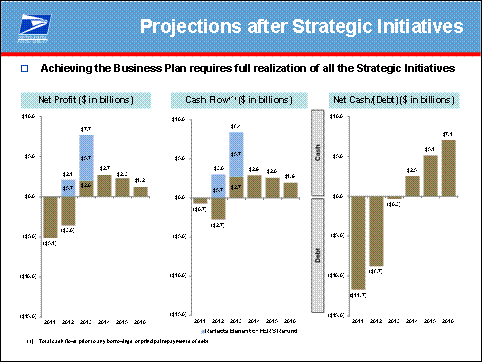
Figure 8
The Plan to Profitability represents a bold and decisive move forward in continuing to transform the Postal Service into a 21st century postal system. There is no disagreement that the Postal Service is currently at a critical juncture in its long history. Action is the key to bringing about needed changes to an outdated business model. This action must come from across all stakeholder lines. The Postal Service continues to do everything within our control to bring costs in line with revenues, return the Postal Service to financial stability and preserve the affordability of mail. Congress must also act to enable implementation of these strategies and goals. Employees, the mailing industry, union and management organizations and customers also play a part in the success of this plan. I look forward to working with each of you to keep the Postal Service an integral and dependable delivery service to all Americans for many years to come.
Thank you.
